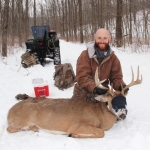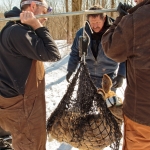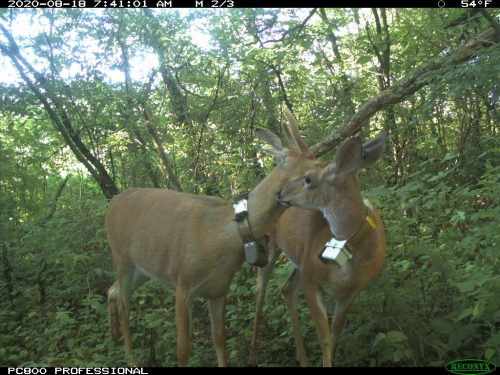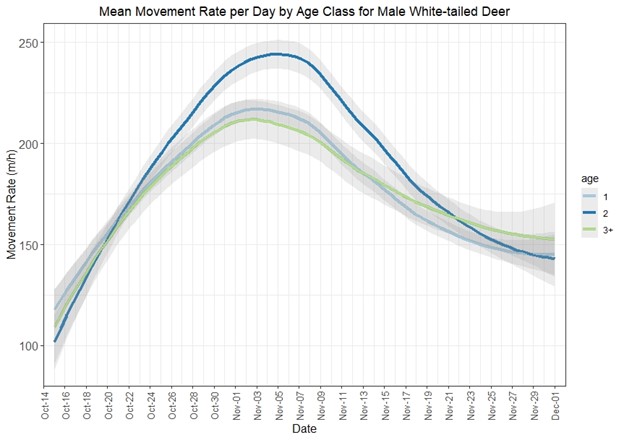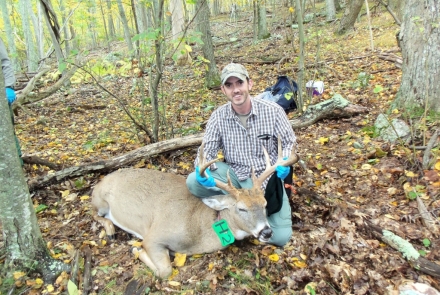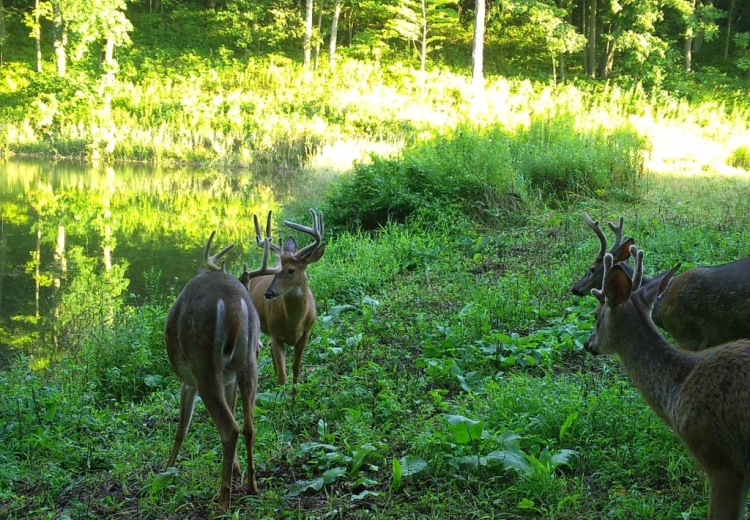December 2023 - Field Notes Newsletter
Want to get notified when new newsletters come out? Sign up for the following topics on GovDelivery.
- Chronic Wasting Disease Updates - For emails about new project newsletters.
- Wisconsin Deer Research - For email updates on all deer projects being done by the Office of Applied Science.
For more Field Notes newsletters, please see the Field Notes Newsletter Index.
Where'd That Buck Go? Buck Movement Ecology During The Rut
As a researcher and a hunter, Matt Hunsaker studied where bucks go during the rut as part of his master's degree project.
Follow A Buck
Follow one of the bucks Hunsaker studied throughout three breeding seasons.
Collaborator Highlight: Dr. Daniel Walsh
Walsh, unit leader for the USGS Montana Cooperative Wildlife Research Unit, has been part of the study since the very beginning. “I want to start making a difference. That’s the deeper motivation. That’s the thing about this project — I can see how this could become a foundation for action.”
New: Deer And CWD Scientific Publications List
Check out this new resource for peer-reviewed scientific papers from deer and chronic wasting disease research efforts. Papers are listed in chronological order and divided by topic, with key findings listed under each paper.
Where'd That Buck Go?
Deer season is winding down. Deer hunters gather to tell stories of the season, and at the top of most discussions is: Where’d that buck go? You saw him on your trail camera and were hoping for one of those magical encounters that every hunter dreams about.
Matt Hunsaker, a researcher and avid deer hunter, has been asking the same question. His research, which was the basis of his master’s degree at the University of Wisconsin-Madison, focused on buck movement ecology during the breeding season, examining daily movement rates and range changes for white-tail bucks and determining peak breeding season for the species. Hunsaker’s studies began as a technician (and eventually, field crew leader) on the Wisconsin DNR’s Southwest Wisconsin CWD, Deer and Predator Study in 2018, collaring deer and conducting mortality checks.
Hunsaker's interests expand past “Where’s the buck?” While his study focused on buck movement, it was in the context of the spread of CWD. “There are obvious implications that need to be noted for CWD within buck movement and the rut. We were looking at movement ecology during the breeding season, answering questions and making assumptions on what might be going on with CWD, considering our findings, leading to many more questions. So, this study is setting a foundation for understanding those dynamics down the road,” said Hunsaker.
The Big Debate – When Is Peak Rut?
So, when is the peak rut, or when the bucks are moving the most? While Wisconsin hunters tend to agree that it occurs late October through early November each year, there is a lot of hunting lore about how the moon phase, temperature, changes in barometric pressure and many other factors might influence the timing of the rut. Many hunters enjoy debating and speculating on which factors shape the rut, and some hunters even plan their hunting vacations around when they think rut movements will peak. However, it is difficult to discern these patterns since hunters can only spend so much time in the woods and only one place at a time, limiting what can be observed. Researchers work around this challenge by GPS collaring deer to track individual deer 24/7. While collars can’t provide complete knowledge on what exactly deer are doing from location data, they are a powerful tool that allows us to learn things about deer that may not be possible using observations from tree stands or trail cameras.
Hunsaker used the data from nearly 200 of the 319 GPS-collared bucks he helped collar for the Southwest Wisconsin CWD, Deer and Predator Study. The GPS collars took hourly locations from mid-October through November from 2017-2020. Hunsaker tracked a buck’s movement rate and daily range size using these many data points. He measured buck movement rates in meters per hour, and with the 24 GPS locations gathered over the course of a day, Hunsaker could calculate an average movement rate per day for each buck. Because the buck’s age was determined at the time of capture, he could also evaluate that movement data across age classes.
“I used a yearling, 2-year-old and then a 3 and older age class, so we can compare age classes in terms of rut-based movement,” said Hunsaker. The same method was used when determining the daily range, or the area a buck is using on a given day. He then used statistical models to see how movement rates and range sizes changed by day and age class (yearling, 2-year-old and 3-year-old and older) and whether movement rates and range sizes were influenced by temperature (both daily minimum and daily maximum) and hunting season (archery, opening weekend of the firearm season and the rest firearm season).
In addition, Hunsaker compared the movement data with the estimated conception dates in those same years, determined from fawn captures conducted for the Southwest Wisconsin CWD, Deer and Predator Study the subsequent spring. Deer gestation is, on average, 200 days. Fawns were captured soon after birth, so backtracking 200 days from an estimated birth date gave the conception dates Hunsaker used to determine when most fawns were conceived: in other words, the rut.
Hunsaker applied a statistical test called change point analysis to the movement rate, range size and conception datasets, which determined that the dates of highest movement and range size closely matched when most fawns were conceived: Oct. 23 - Nov. 12. This consistency between movement patterns and fawn conception gives us a lot of confidence that the movement data is capturing the rut. Hunsaker found that temperature and hunting season did not influence buck movement rates or range sizes. He also looked at whether buck movement differed year-to-year in case other variables might influence the timing of the rut – but rut movements did not differ between years. Only two variables mattered when it came to daily movement rates and range size: calendar date and age class.
Age Class And Calendar Date Determines Peak Rut
Let’s first discuss why rut dates were so consistent and seemingly unaffected by external conditions. The timing of the breeding season is all about ensuring that fawns are born during a time that gives them the best chance of survival (late May and early June in Wisconsin). Remember that deer gestation is approximately 200 days. Neither temperature nor moon phase nor any other environmental factor can ensure that fawns are consistently born at the best time of year. The factor that does matter is photoperiod, or the length of time the sun is out each day. Photoperiod changes are consistent, and deer biology, like that of many animals, is strongly affected by it. That is why the timing of the rut is so consistent.
The calendar date is the proxy for photoperiod and is a large driver of rut-based deer movement. It’s not news that buck movements change based on calendar dates, but the details are interesting. Hunsaker created the figure below to examine movement patterns through time. The curvy lines represent the average movement rate on each day, from Oct. 15 to Dec. 1, separated by buck age class: light blue for yearlings, dark blue for 2-year-olds and green for the ages 3 and older bucks.
First, notice that movement rates more than doubled from Oct. 15 to the absolute peak, approximately Nov. 1-7. That’s an incredible amount of change happening in a short time frame. Notice, too, that the movement rates taper off more slowly as the rut winds down. The age classes didn’t differ in terms of when their movement increased, but the most unexpected result is that 2-year-old bucks, on average, have a peak movement rate that is more than 10% higher than both yearlings and older bucks.
Why are 2-year-old bucks more active than older bucks? The key here is that these are averages across all bucks on each day, within each age class, which doesn’t tell us the whole story. Older bucks may have lower average movement rates than a 2-year-old because older bucks are more successful at tending and mating with does. A buck that is tending a doe will have a much lower movement rate than a buck that is actively searching for a receptive doe. This means a greater percentage of older bucks on any given day during the rut will be tending rather than searching, leading to a lower movement rate in comparison to younger bucks. This phenomenon of drastically reduced movement rates on certain days during the rut is illustrated nicely in the next article, where we examine the movement rates of an individual buck. This matters to hunters because it partially explains why those older bucks can be so difficult to harvest.
With the rut tailing off around the time of the firearm hunting season, how does that affect buck movement? Hunsaker factored the hunting season in his analyses, and according to the data, there wasn’t a significant impact. “The hunting season didn’t significantly impact [buck movement] with hourly GPS data, but the takeaway is that bucks are already on the downward trend of the rut. Whether there’s a hunt or not, they’re already reducing their movement rates,” said Hunsaker.
How Can This Affect CWD Spread?
Hunsaker’s study gives a glimpse at one of the ways CWD continues its slow, determined spread across the landscape.
Over time, the breeding season could help explain some spatial spread beyond factors like dispersal events (which was investigated by Hunsaker’s colleague Dr. Marie Gilbertson, featured in the November 2022 newsletter). “We know those older males tend to have a high CWD prevalence. During the rut, bucks are expanding their range while also directly and indirectly contacting a lot of other individuals, bucks and does. That expansion and contact are drivers of that slow spatial spread,” said Hunsaker.
Hunsaker’s work paves the way for a better understanding of buck movement and breeding ecology during the breeding season and is the first step to understanding how this adds to the spread of CWD across the landscape. Research stemming from his study could increase our understanding of white-tailed deer movement and CWD implications. Hunsaker thinks it is worth focusing more on breeding success and its possible link to the risk of acquiring CWD, perhaps by using GPS collars fitted with cameras to better link deer behavior to movement data. Evaluating how bucks use certain habitats (and the potential increase in prion loads in environments from this use) and studying doe movement during the rut are also future directions Hunsaker specified. There is a lot more from Hunsaker’s research that we’ll share in the future, including daytime versus nocturnal movement and how those change during the rut. Stay tuned!
Hunsaker is currently transitioning to a position as a state biologist with the Illinois DNR, where he’ll work on active CWD management and education for the public and hunters. He’s working on publishing a paper detailing his research on buck movement and breeding ecology on the side. Make sure to check the Deer and CWD Scientific Publications to read the paper when it is published.
Follow Buck 5700 Through Three Breeding Seasons
Let’s look at an example of a buck expanding his range and his varying movements through his first three breeding seasons. Here, we have buck 5700, captured and collared by the research team in February 2017 while working on fieldwork for the Southwest Wisconsin CWD, Deer and Predator Study. He was approximately eight months old, weighed 90 pounds and was CWD negative at the time of capture. The study used expandable GPS collars that stretch during the rut and have pleats that pop to allow the collar to expand as the buck grows. In addition to collecting location data, the collars also let researchers know if the buck hasn’t moved in 4-6 hours, potentially indicating a mortality.
5700’s fate is unknown; by design, the elastic on the collar broke, and the collar fell off in December 2019. However, he gave us great data that helped us understand movement rates and changes throughout three breeding seasons (2017, 2018 and 2019).
5700’s Movements And Ranges During Breeding Season 2017-2019
In the graph below, 5700’s daily range and movement rates as a yearling (light blue), 2-year-old (dark blue) and 3-year-old (green) are shown during the time range of Oct. 15-Dec. 1, encompassing most of the breeding season. You can see a major increase in movement between 5700’s yearling season and his 3-year-old season. Large spikes in movement and range fall right between Hunsaker’s identified peak rut: Oct. 23-Nov. 12. In his 3-year-old year, 5700 shows a likely breeding and tending event on Nov. 7, identified by the asterisk in the graph. Although this is probably not the only breeding event for him, the Nov. 17 movement drop is the most obvious example of the idea that a dip in movement indicates breeding or tending.
2017: Yearling
As a yearling, 5700 has increased activity during the peak breeding season. For most of October, his range was approximately 299 acres, but that expanded to 457 acres during peak rut. He makes a lot of big jumps between forested areas, on par with what was found in an earlier study by Hunsaker’s colleague, Dr. Marie Gilbertson, on how deer use the landscape. In his first year, 5700 showed signs of early rut activity but may have conflicted with more mature bucks, potentially leading him to stick to a smaller area and conserve energy for survival.
2018: 2-Year-Old
In 2018, 5700 greatly increased his movements and his range. During peak rut, his range covered 822 acres (before that, his range was about 292 acres). Here, you can see he is developing patterns of “searching and tending” as he finds a receptive doe, stays with her for approximately 24 hours and then continues his search for the next estrus doe.
2019: 3-Year-Old
5700 continues the searching and tending pattern in 2019, but his normal range (348 acres) and the range he expanded to during peak breeding season (843 acres) stayed relatively consistent as the previous year when he was a 2-year-old. He shows a likely breeding and tending event on Nov. 7 that occurred over that day, as seen in the above graph.
Collaborator Highlight: Dr. Daniel Walsh
WHAT IS YOUR ROLE IN THE SW CWD STUDY?
Walsh is the unit leader for the U.S. Geological Survey (USGS) Montana Cooperative Wildlife Research Unit, which has been involved in the study since the conception of the Southwest CWD, Deer and Predatory Study. He helped design the study and consulted with the project’s lead scientist, Dr. Dan Storm (Wisconsin DNR), and ecological statistician Dr. Alison Ketz (UW-Madison) on data analysis and modeling of the data collected.
“I’ve been largely involved in leading the data analysis aspects of the project, particularly around developing the survival and integrated population models that are key to assimilating all the information we’ve been collecting into a form that allows us to understand what the populations are and will be through projections in the future and how [deer populations] are responding to CWD in Southwestern Wisconsin,” said Walsh.
HOW WILL YOUR BACKGROUND HELP STUDY CWD?
Walsh received his master's from Colorado State University and a second master's and Ph.D. from Michigan State, with both his degrees focusing on the quantitative aspects of wildlife and wildlife health.
He was introduced to CWD in the epicenter of it all while working for five years at Colorado Parks and Wildlife after completing his education at Michigan State. Walsh then spent the last decade at the USGS National Wildlife Health Center before moving to his current position with the USGS Montana Cooperative Wildlife Research Unit. While CWD is a major part of his research portfolio, Walsh has also worked with other heavy hitters: big horn sheep respiratory disease, white-nose syndrome in bats, avian influenza, and Newcastle disease.
Across all these diseases, Walsh said, there have been good efforts surveilling and characterizing the problem. “I think where we often struggle is when it comes to successfully managing the disease because managing wildlife health issues are very complex, not just the ecology and epidemiology, but their political and social aspects,” said Walsh.
There’s no easy solution, especially since diseases don’t recognize political boundaries. Herd health issues cross state lines, but disease management, like CWD management in Wisconsin and Illinois, for example, doesn’t always crossover. The USGS publishes a map that shows the continual spread of CWD across the U.S., which Walsh sees as a wake-up call. “We can’t continue to think about this just in terms of CWD. We have to think about this as a deer issue and how deer are interacting on the landscape and start to work together in a much broader framework,” said Walsh.
This includes understanding the social drivers. “We have to think about how CWD fits into society and is driven by human decisions and actions,” Walsh said. With CWD, management efforts rely heavily on hunters, Walsh explained, and if hunters aren’t able or willing to participate in management efforts, this lack of participation will heavily determine the success of the disease management.
Thinking about CWD more broadly has led to the use of systems modeling, which helps wildlife health scientists like Walsh better visualize and understand the disease, wildlife health and the ecosystem they exist in. “This overall idea of moving away from disease to health and thinking about it holistically, I believe, is the only way we’re going to gain traction on these problems. And it must be done at the scale that the disease is operating on, and that’s where these regional efforts have to come to fruition,” Walsh said.
This requires working with people from all sides. “That’s where the future has to go. If you work in this field long enough, you realize that you have the science, but it’s really about how you interact with people both within the agency and outside the agency, actually across agencies, as well as all those people that we’re serving,” said Walsh.
WHY JOIN THE SOUTHWEST WISCONSIN CWD STUDY?
Multiple reasons led Walsh to the Southwest Wisconsin CWD, Deer and Predator study. First, the people he would be working with — an important aspect of such a collaborative study.
“I like the [Wisconsin] DNR folks that would be part of the project. I knew they would be doing rigorous science; this wouldn’t just be a box-checking exercise. They had real questions, real hypotheses and were willing to put in the resources to test those hypotheses,” said Walsh.
The other draw to the project was the scale. The Southwest Wisconsin CWD, Deer and Predator study put out an impressive 810 collars on adult deer (and 323 collars on fawns) to study them over several years, tracking movement and survival. Predators were also collared and included in the study to better understand predator impacts on deer and CWD. Multiple datasets are being used, cumulating decades' worth of data that Wisconsin has already been collected on its deer population. There’s a lot on the table to work with. It’s taking a more holistic, system approach to studying CWD.
Most of all, Walsh saw a path to action. “I want to start making a difference,” said Walsh. His work typically models the spread of wildlife disease across the landscape, but he hasn’t been able to do anything about the spread. “That’s the deeper motivation. That’s the thing about this project — I can see how this could become a foundation for action,” Walsh said.
“The people, the scale of the project, good research questions…and that I can see a path of what Wisconsin is trying to do [about CWD] that will hopefully lead to action, not only within Wisconsin but also working regionally with other states,” Walsh said.
WHAT DO YOU LOOK FORWARD TO LEARNING FROM THE INTEGRATED POPULATION MODEL (IPM)?
“I think [the IPM] links to this paradigm of approaching CWD more holistically and at regional scales. What the IPM will give us and what I’m looking forward to understanding is what’s happened historically in terms of the population disease processes in southwestern Wisconsin, which will then hopefully provide some insights on future management directions, not only for Wisconsin but across the Midwest region,” said Walsh.
In addition to increasing understanding of what has already happened in the system, the IPM can help forecast CWD management choices and the impacts those choices will have on deer and CWD.
“That can be powerful in terms of determining the urgency of action in various regions or even what kind of actions should be applied. We can play with the model and determine the potential impacts on CWD and deer populations by applying some management action. This allows us to look at potential future states of the system under different management strategies and choose the one most likely to be effective,” said Walsh.
Once the IPM is completed, Walsh believes the framework for the model could be applied in other states, especially states with similar datasets. “If the state has very similar data streams, they can use this framework and populate it with their information to get the same benefits,” he said. Even for western states (which must also account for elk, mule deer and moose), the structure of the IPM could set a foundation and only require a few add-ons to tailor to their ecosystem.


